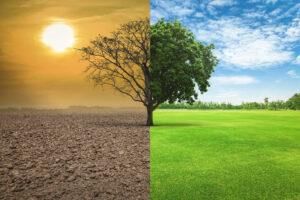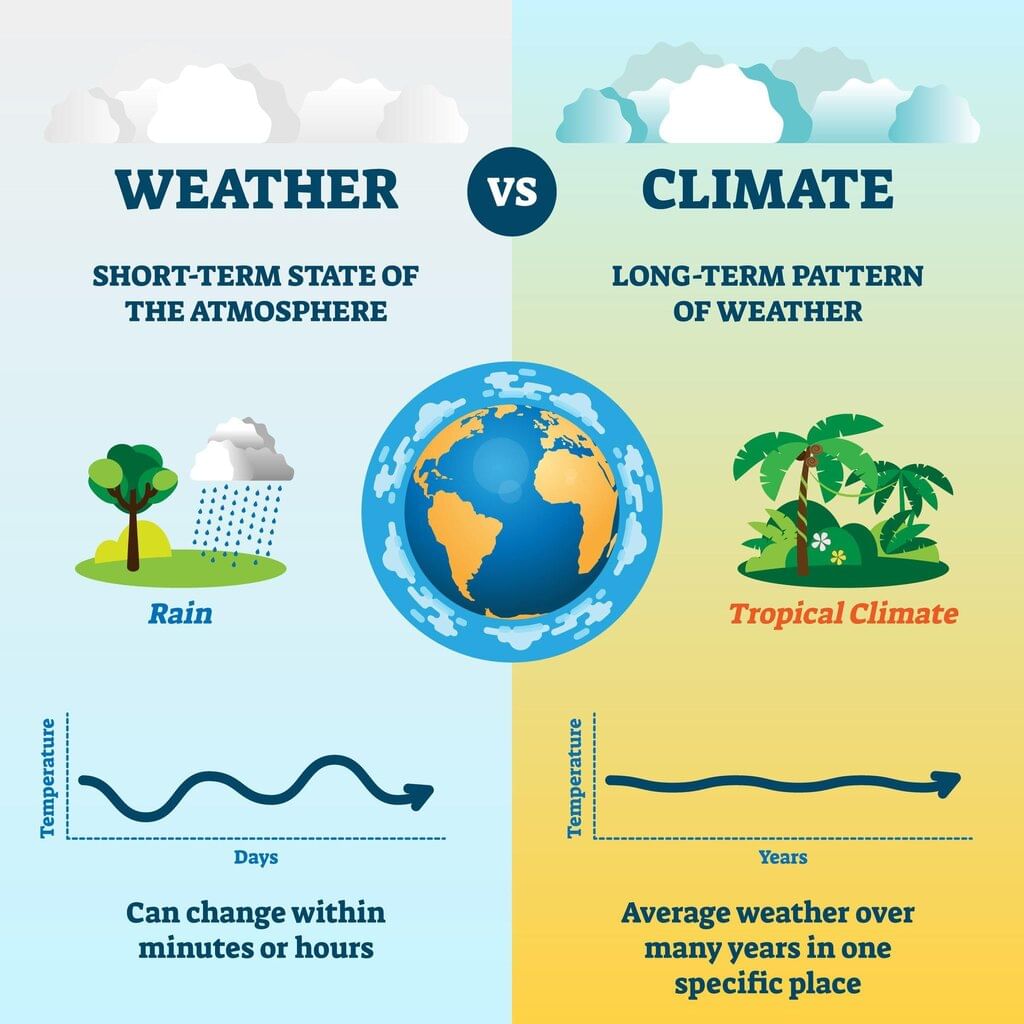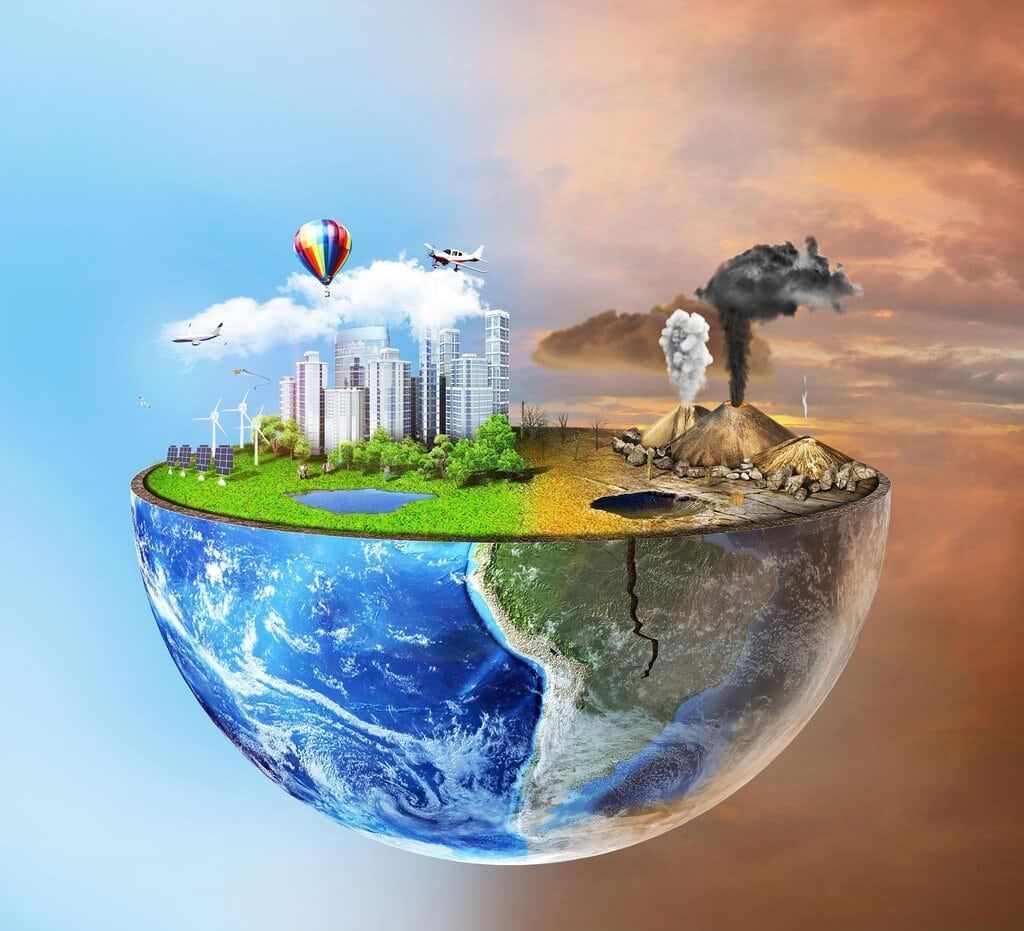Weather and Climate Chapter Notes | Social Studies Class 5 ICSE PDF Download
| Table of contents |

|
| Introduction |

|
| Weather |

|
| Climate |

|
| Difference between Weather and Climate |

|
| Factors that Affect Climate of a Place |

|
| Points To Remember |

|
| Glossary |

|
Introduction
Weather and climate are important parts of our daily lives. They decide how hot or cold it is, whether it will rain or be sunny, and how we should dress or plan our activities. This chapter teaches us about the difference between weather and climate, what makes the weather change every day, and how climate stays the same over many years in a place. We will also learn about the factors like distance from the sea, height of a place, and winds that change the climate. By understanding these, we can know why some places are hot, cold, or rainy, and how people study weather and climate using science.

Weather
- Weather is the condition of the air around us on a particular day, including how hot or cold it is, how much water is in the air, how fast the wind blows, and if it rains.
- It tells us if a place feels hot, cold, dry, wet, stormy, clear, or cloudy.
- Weather can change a lot in one day; for example, it might be sunny in the morning, rainy in the afternoon, and windy at night.
- Some days are hotter, while others are colder, depending on the weather.
- Weather decides what we do each day; for example, a sunny day is good for playing outside, but a rainy day is not good for a picnic.
- People use science and technology to predict the weather of a place.
- The science that studies the air, weather processes, and predicts weather is called meteorology.
- Scientists who study meteorology are called meteorologists.
Fun Fast
Weather reports in newspapers tell us the highest and lowest temperatures, the amount of water in the air, and how much rain fell in the last 24 hours. These reports also predict the weather for the day.
Climate
- Climate is the average weather condition of a place over a long time, like 30 years.
- It does not change much throughout the year in some areas of the world, while it changes a lot in other areas.
- If the temperature at a place stays high most of the time in a year, we say the climate of that place is hot and dry.
- If a place gets very little rain most of the year, we say the climate of that place is hot and dry.
- Climate affects the food people eat, the clothes they wear, the way they travel, and the types of houses they live in.
- The study of climate climate is called climatology, and the people who study it are called climatologists.
Difference between Weather and Climate

Weather
- Weather describes the conditions of a place for a short time.
- Weather can change a lot within a short time.
- Weather affects the daily activities of people, like deciding what to wear or what to do.
Climate
- Climate is the average weather condition of a place over a long time, like 30 years.
- Climate stays stable for a long time and does not change quickly.
- Climate affects the food, clothes, transportation, and houses of the people in a place.
Factors that Affect Climate of a Place
 Many factors change the climate of a place, making it different in various parts of the world.
Many factors change the climate of a place, making it different in various parts of the world.
Latitude or Distance from the Equator
- Latitude means how far a place is from the equator.
- Places near the equator are hotter because they get direct sun rays.
- Places far from the equator are cooler because they get slanting sun rays.
- The Earth is round and tilted, so the sun’s rays fall differently on different parts of the Earth.
- Direct sun rays near the equator make the area very hot.
- Slanting sun rays far from the equator spread over a larger area, so they are weaker and make the area less hot.
Altitude
- Altitude is the height of a place above sea level.
- Sea level is the same all over the world because all seas are connected.
- Sea level is used as the starting point to measure the height of a place.
- The climate of a place changes with its height above sea level.
- Air near the Earth’s surface is denser and holds more heat, so places at lower heights are hotter.
- Air at higher altitudes is thinner and holds less heat, so places at higher heights are cooler.
- That’s why mountain peaks are covered with snow in winter and hill stations are cold even in summer.
- For example, Jalandhar and Shimla are at the same latitude, but Shimla is cooler than Jalandhar because Shimla is at a higher altitude, while Jalandhar is at a lower altitude.
Distance from the Sea
- How far a place is from the sea changes its climate.
- Places near the sea have a moderate climate, which means they are not too hot or too cold.
- Places far from the sea have an extreme climate, which means they are very cold in winter and very hot in summer.
- The climate of places near the sea is affected by land and sea breezes.
Sea Breeze and Land Breeze
- During the day, land gets hotter faster than water, so the air above the land gets hot and rises up.
- Cool air from the sea moves towards the land to take its place, and this is called a sea breeze.
- Sea breeze cools down the temperature of places near the sea.
- At night, the land cools faster than water, so the air above the sea is warmer and rises.
- Cool air from the land moves towards the sea, and this is called a land breeze.
- Land breeze also makes the climate of coastal areas moderate by balancing the temperature.
Humidity and Rainfall
- Humidity is the amount of water vapor or moisture in the air.
- Places closer to the sea have more humidity because there is more water nearby to turn into vapor.
- Places far from the sea have less humidity because there is less water around.
- In the rainy season, when humidity is high, the climate of a place becomes wet as it causes rainfall.
- High humidity also causes snowfall in very cold places.
Fun Fast
- Humidity is measured using an instrument called a hygrometer.
- Rainfall, snowfall, and drizzle are known as precipitation.
Direction of Winds
- Air that moves horizontally is called wind.
- Hot winds make a place warmer, while cold winds make it cooler.
- Winds that pass over water bodies carry moisture and bring rain to the places they blow towards.
- In India, seasonal winds called monsoons affect the climate.
- The south-west monsoon winds bring rain from June to September.
- The north-east monsoon winds bring rain in December and January.
Points To Remember
- Weather affects the day-to-day activities of people, like what to wear or what to do.
- Climate is the average weather condition of a place for a long time, like 30 years.
- Climate affects the food, clothes, transportation, and houses of the people in a place.
- Factors like height, distance from the sea and wind direction change the climate of a place.
Glossary
- Altitude: The height of a place above sea level.
- Humidity: The amount of water vapor in the air.
- Forecast: A prediction of future weather events.
- Phenomena: An event or occurrence that can be observed.
|
68 docs|20 tests
|
FAQs on Weather and Climate Chapter Notes - Social Studies Class 5 ICSE
| 1. What is the difference between weather and climate? |  |
| 2. What are some factors that affect the climate of a place? |  |
| 3. How does weather impact our daily lives? |  |
| 4. Can climate change affect weather patterns? |  |
| 5. What fun activities can help me learn more about weather and climate? |  |




















